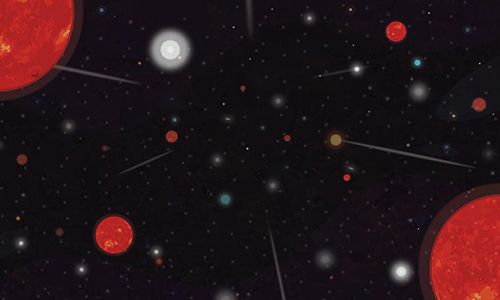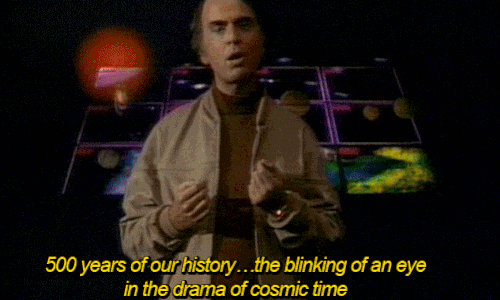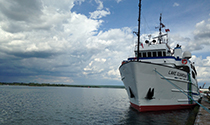|
|
|
|
| |
|
|
| |
| |
|
|
| |
UChicago scientists are working diligently to understand and combat COVID-19. Read about the science, find answers to your questions about the coronavirus, and stay up-to-date with University efforts to protect the community and beyond.
Other UChicago scientists are still conducting research, albeit remotely. This issue includes faculty working very remotely--studying objects millions of light-years away from campus. |
|
| |
|
|
|
|
| |
|
|
| |
|
|
| |
|
|
|
|
|
| |
|
|
| |
You may remember from school the raisin bread analogy for the expanding universe: as the dough uniformly expands, two raisins in the center don't move very far apart from each other, but one raisin in the middle and one on the dough's surface spread apart much farther in the same amount of time. |
|
| |
|
|
|
| |
|
|
| |
This is happening in the cosmos: space is expanding all around us, carrying galaxies with it, and farther galaxies are fleeing faster than nearby ones. Exactly how fast the universe is expanding depends on whom you ask. |
|
| |
|
|
|
|
|
| |
|
|
| |
|
|
| |
| |
|
|
| |
(Illustration by Norval Glover) |
|
| |
|
|
|
|
| |
|
|
|
|
|
| |
|
|
| |
A siren sounds different as it races past you and off into the distance; that's the Doppler effect, which results from a change in wavelength based on relative position. The same happens with light; when an object moves away, its color shifts into the red end of the spectrum. Edwin Hubble noticed this redshift for distant galaxies and concluded in 1929 that the universe was expanding. We now call the rate of its expansion the Hubble constant. |
|
| |
|
|
|
| |
|
|
| |
The problem is that different methods of measuring this "constant" return different values, with enough discrepancy between them that there may be undiscovered physics at work. Or the measurements are wrong. No one's sure, and this has caused tension in the observational astronomy community. Wendy Freedman, whose team made a landmark Hubble constant measurement in 2001, offers a new method: measuring distance using "tip of the red giant branch" stars--what stars like our sun briefly become before they die. Her results seem to bridge the divide, but the debate smolders on. |
|
| |
|
|
|
|
|
|
|
| |
|
|
| |
|
|
|
| Standard candles are indispensable for measuring cosmic distances, which when combined with velocity give the universe's rate of expansion. |
|
|
|
| |
|
|
|
|
|
| |
|
|
| |
|
|
|
| The first standard candles identified were Cepheid variables, pulsating stars that vary in brightness at regular intervals that can be translated into distance. Henrietta Leavitt, a Harvard "computer" and astronomer, discovered this relationship, making Hubble's measurements possible. |
|
|
|
| |
|
|
|
|
|
| |
|
|
| |
|
|
|
| Astrophysicist Daniel Holz, SM'94, PhD'98, explains how gravitational waves can be used to measure the Hubble constant. |
|
|
|
| |
|
|
|
|
|
|
|
|
|
|
|
|
|
| |
|
|
| |
|
|
| |
| |
|
|
| |
The "cosmic calendar" appeared in the first episode of Carl Sagan's 13-part television series, Cosmos: A Personal Voyage (1980). The show's special effects were considered groundbreaking at the time. |
|
| |
|
|
|
|
| |
|
|
|
| |
|
|
| |
The Hubble constant can be used to determine the age of the universe. Currently the accepted age is about 13.8 billion years old. |
|
| |
|
|
|
| |
|
|
| |
It's hard to wrap your brain around such a large number, so Carl Sagan, AB'54, SB'55, SM'56, PhD'60--famed cosmologist, science communicator, and enunciator of the letter B--compressed it into one Gregorian calendar year. |
|
| |
|
|
|
| |
|
|
| |
Sagan's "cosmic calendar"--featured in the first episode of Cosmos--set the big bang on New Year's Day and the show's 1980 airdate at midnight on December 31. Based on the current Hubble constant calculation, we are now about 0.09 seconds into the next year. |
|
| |
|
|
|
|
|
|
|
|
|
| |
|
|
| |
COVID-19:
UChicago is working hard to keep you safe, healthy, and informed.
|
| |
|
|
|
|
| |
Lake effects:
UChicago conducts great science in and on the Great Lakes.
|
| |
|
|
|
|
|
|
|
|
|
|
| |
|
|
| |
| |
|
|
| |
Sign up to receive µChicago monthly. |
|
| |
|
|
|
|
| |
|
|
|






